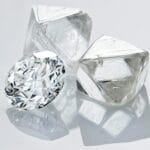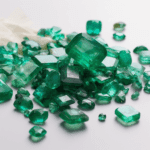Opal: Recognizing and Understanding Opals
Introduction to Opal Opal, also known as Opal, has been circulating on the European continent since 100 B.C. When the Greeks were confronted with this fantastic and extraordinary gemstone, they used a new synthetic word to describe it: Opallions, which means seeing transformations. Since Opal was always produced in Europe in very small quantities (now in the Czech Republic), Byzantine traders deliberately referred to it as Opalus from the East, which is where the English word opal comes from. Opal with colorful light flame, is recognized as the world’s most beautiful gemstone, known as “set the beauty of gemstones in one”. It has the ruby’s gorgeous, amethyst of the noble, emerald of the elegant, sapphire’s stability, bright and charming colors make countless people fall in love with it. Since ancient times, Opal has been sought after by people because of its changing and fascinating colors. Its beautiful color change is like a seven-color dream, giving people a magical reverie. People use Opal as the October birthstone and the 14th wedding anniversary commemorative gemstone, which means the stone of hope and happiness. In Europe, Opal is considered a representative of good fortune. The ancient Romans called it “Cupid’s beautiful boy”, symbolizing hope and purity. Common Opal Varieties Precious Opal: This is the most valuable type of opal and is characterized by its play-of-color. Precious opal can exhibit a wide range of colors, and its value is determined by factors such as the intensity, pattern, and variety of colors. Common Opal: Unlike precious opal, common opal does not display play-of-color. It comes in a variety of colors, but its value is primarily based on factors like color, transparency, and overall quality. Fire Opal: Fire opal is known for its vivid orange to red colors. It may or may not display play-of-color. The intensity of the orange and red hues is the key factor in determining the value of fire opals. Black Opal: Black opal is a type of precious opal that has a dark body color, often black or dark gray. The play-of-color in black opals tends to stand out more vividly against the dark background, making them highly prized. White Opal: White opal has a light or white body color and can exhibit a play-of-color similar to precious opal. The colors may be more subdued compared to black opal, but white opals are still valued for their beauty. Boulder Opal: Boulder opal is found in combination with ironstone. The opal forms in thin layers within the cracks and crevices of the ironstone, creating unique patterns. The ironstone is often left on the back of the opal, adding to its natural appearance. Crystal Opal: Crystal opal is transparent to semi-transparent and has a play-of-color. The body of crystal opal can be colorless or have a faint color, allowing the play-of-color to be more visible. Jelly Opal: Jelly opal is a translucent to opaque type of opal with a jelly-like appearance. It may or may not display play-of-color, and its name is derived from its gelatinous appearance. Formation of Opals Formation in Sedimentary Rocks: Opals often form in sedimentary rocks such as sandstone and shale. Silica-rich water seeps through the rock, carrying dissolved silicon dioxide (SiO2), which is the primary component of opals. Interaction with Silica Gel: As the silica-rich water moves through the rock, it fills cracks and cavities. Over time, this water evaporates or loses its silica content, leaving behind a gel-like substance composed of tiny silica spheres. Play-of-Color Formation: The unique play-of-color in opals is a result of the interference and diffraction of light caused by the silica spheres. The size and arrangement of these spheres determine the colors visible in the play-of-color phenomenon. Composition of Opals: Silicon Dioxide (SiO2): Opals are primarily composed of silicon dioxide, the same mineral that makes up quartz. In opals, the silica is amorphous, meaning it does not have a crystalline structure, contributing to the gemstone’s unique properties. Water Content: Opals contain water, typically ranging from 3% to 21% by weight. The water content is crucial to the opal’s play-of-color, and variations in water content can affect the appearance of the gem. Microstructure: Opals have a unique microstructure consisting of microscopic silica spheres arranged in a regular or irregular pattern. The size and arrangement of these spheres determine the play-of-color characteristics. Trace Elements: Opals may contain trace elements such as iron, manganese, and carbon, which can influence the gem’s color. Iron oxides can contribute to the red, orange, and brown colors seen in some opals. Types of Opals Based on Composition: Precious Opal: Contains a significant amount of water and exhibits play-of-color. Common Opal: Lacks the play-of-color phenomenon and has a lower water content compared to precious opal. Fire Opal: Characterized by its vivid orange to red colors and lower water content compared to precious opal. Opal Colors and Characteristics Opals are renowned for their vibrant play-of-color, and their colors can range across the entire spectrum. The unique display of colors is influenced by various factors, including the type of opal, the arrangement of silica spheres, and the presence of trace elements. Here are some key opal colors and characteristics: Play-of-Color: The most distinctive feature of opals is their play-of-color, which is the vibrant and iridescent display of colors that can change with the viewing angle. The play-of-color is a result of the diffraction and interference of light as it passes through the microscopic silica spheres within the opal. Multicolor Displays: Opals can exhibit a wide range of colors, including red, orange, yellow, green, blue, indigo, and violet. Some opals display a multitude of colors simultaneously, creating a mesmerizing and dynamic appearance. Body Color: The body color of an opal refers to the base color of the gemstone when the play-of-color is not present. Opals can have various body colors, including white, black, gray, and crystal clear. Black Opals: Black opals have a dark body color, often black or dark gray, which enhances the visibility of the play-of-color. The dark background provides




